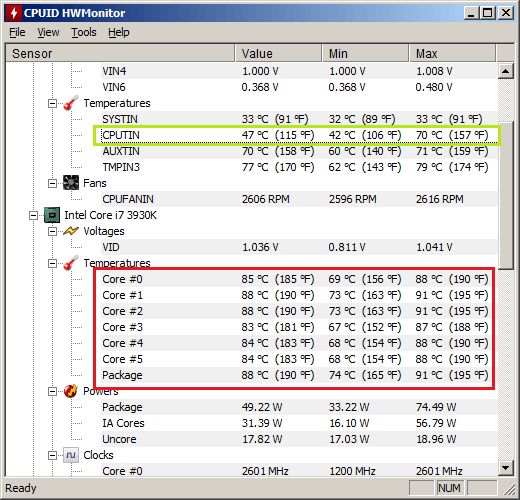1
This image demonstrates what I'm talking about:

The motherboard's CPU temperature is in green. The individual cores' temperatures are in red.
I've tested the temperatures in three different scenarios:
- Idle: All cores <5% utilization. Core temperatures are around 70C, while CPU is around 55-60C. Frequency stays around 2600 Mhz.
- Gaming: Three of six cores around 50% utilization, remaining three <10%. Core temperatures gradually increase to 90C. CPU temperature gradually decreases to 40C. Frequency is gradually reduced to 1200 Mhz. Pictured above.
- Stressed: Using Intel's diagnostic tool to stress the CPU; all cores near 100% utilization. All cores are over 90C, while CPU is at 80C (I believe the tool limits itself if it goes above 80C). I can't monitor frequency during this.
Why are the two readings so different? Also, why does the motherboard's reading decrease while gaming, even though the Core readings are almost as high as they are during the stress test?
4CPUTIN varies between motherboard manufacturers and is often simply wrong (some vendors don't have the sensor and thus CPUID reads bogus data), sometimes the sensor is wrong, and sometimes it just reads something unrelated - if you stress the system, the fans will likely turn on/faster, which may end up decreasing some temperatures, especially those of components that normally don't get any cooling (northbridge/southbridge, memory, etc.) – user2813274 – 2015-06-22T04:13:13.150
@user2813274: I have liquid cooling. The fans are constant. When I stress the system, all temperatures become extremely high. – dauphic – 2015-06-22T04:15:24.773
1@dauphic then you have an issue with your cooler/heatsink; try reapplying the thermal paste and ensuring the radiator is functioning correctly. The values you outlined in your screenshot with a red box are the actual CPU temperature values. Indeed, in your screenshot, CPUTIN is simply wrong, and your CPU is indeed running at 88 C. – Breakthrough – 2015-06-22T04:19:41.177
@Breakthrough: The cooler is functioning correctly, and I've already reapplied thermal paste and reseated it. I can feel it transferring heat between the radiator, as well as a change in exhaust temperature when idle vs. stressing. – dauphic – 2015-06-22T04:20:54.350
@dauphic just because it's transferring some heat doesn't mean it's transferring it effectively. I have an air cooled computer and my temperatures come nowhere near that under 100% load, with a higher thermal load too (86W). If your radiator is fine, my guess is you used too much thermal paste, or it's not making enough contact with the CPU die. Indeed though, it looks like your CPU is being throttled due to high temperature. What are your temperatures at idle? – Breakthrough – 2015-06-22T04:22:07.980
@Breakthrough: http://i.imgur.com/g6HIbTK.png I reapplied thermal paste as a result of this behavior, and then re-reapplied it when it didn't approve, with no change. I saw a ~5C decrease after the first reapplication, though. Yes, the CPU is being throttled. I suspect the CPUTIN is lower while gaming because it's running at 50% frequency, therefore generating less heat. By extension, this makes me suspect that CPUTIN is more correct.
– dauphic – 2015-06-22T04:26:35.353@dauphic that is way too hot at idle; my idle temperatures, again air-cooled, don't exceed 35C. There is clearly an issue with your cooler setup; you might want to put the stock cooler (or another air cooler) back on until you can figure out why your liquid cooling setup isn't working correctly. If you're sure you're using the proper amount of thermal paste (which is as little as possible), make sure it's making strong enough contact with the CPU die. If you use too much thermal paste, or there isn't enough contact, you're effectively insulating all the heat inside the CPU. – Breakthrough – 2015-06-22T04:27:53.703
Also why would you suspect
CPUTINto be correct, even though you have seven different thermometers, inside the CPU die itself? Of course I don't doubt that a thermometer can malfunction, but why would you trust an external sensor value - especially one that is widely known to provide inaccurate or constant values - over several independent readings from inside the CPU itself? – Breakthrough – 2015-06-22T04:36:47.633@Breakthrough: Because
CPUTINis reflecting temperatures that logically make sense.CPUTINis 60C at 2600 Mhz/5% utilization, 40C at 1200 Mhz/25% utilization, and 80C at near 100% utilization. They're generally high, yes, but the relative numbers are sensible. TheCoretemperatures are roughly the same in the 25% and 100% utilization scenario. – dauphic – 2015-06-22T04:42:40.4632I'm sorry, but it is what it is. The thermometers embedded directly in the CPU give you the most accurate reading, and that is what the CPU temperature is (otherwise it wouldn't be getting throttled like it is). And regardless, you clearly have an issue with your CPU cooler. Again, you have seven independent readings inside the actual CPU itself telling you what the temperature is. If the heat isn't being transferred out of the CPU, then of course
CPUTINwill give you a lower reading, as it's an external sensor, and isn't exposed to all the heat (because it's not being transferred out). – Breakthrough – 2015-06-22T04:46:09.933